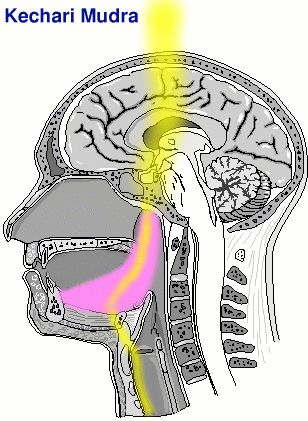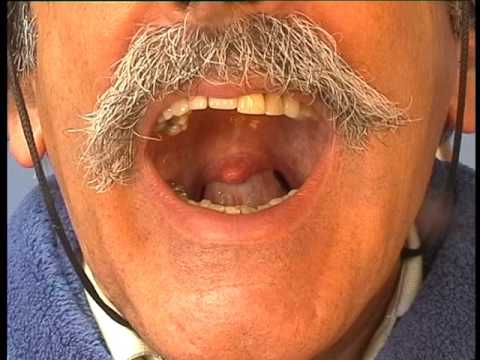Considered to be the king of all the mudras, Kechari Mudra is an ancient yoga technique that helps the practitioner attain a blissful infinite state of consciousness. In Sanskrit, ‘Kha’ refers to the Supreme Reality or ‘Brahman’ and ‘Chara’ means moving. This is an unusual practice of yoga that helps the yogi overcome hunger, thirst, death, and decay.
What Is Kechari Mudra?
Let us try to understand this practice in a simple way. About a centimeter or two above the top of our mouth, a highly sensitive body organ is located that can be reached easily with the tongue. This organ is situated towards the back edge of the nasal septum. When the practitioner’s nervous system is highly purified through advanced yoga techniques, the tongue can roll back to reach the cavity of nasal pharynx up to the soft palate and stimulate the powerful points located inside the cavity. When this is achieved, all the yoga experiences and practices begin functioning on a higher level. This may take a few months to 1 or 2 years of practice.
Kechari Mudra has been practiced by meditators for thousands of years because of the wonderful benefits it offers. Deciding to practice Kechari involves the readiness of nervous system to enter the next level. Regular practice of this Mudra takes the practitioners into a permanent lovemaking of polarities within. The rise of ecstatic bliss is the most important part of the Kechari Mudra. One’s senses are naturally drawn in and it feels as if he is flying from inside.
Stages of Kechari Mudra
According to the location of the tip of the tongue, while performing the Kechari Mudra, there are four stages as explained below.
Stage 1 – In this stage, the tongue moves to the point on the top of the mouth where the soft and hard palettes meet. This point is the demarcation line which must be passed before moving to the stage 2.
Stage 2 – The tongue is rolled up to touch the point behind the soft palate up to the nasal septum. This is a rather short trip but quite momentous. In early practices, it can be performed with the help of finger pushing the tongue and moving to the left or right of the soft palette whichever is easier.
Stage 3 – This stage involves working slowly towards the nasal pharynx and the septum. In this stage, the tongue moves to the bony structure involving the pituitary gland.
Stage 4 – The tongue enters the nasal passage from inside and moves upward beyond the top of the pharynx towards the point located between eyebrows. Though it seems far, it is not so much on the tongue.
Years may pass to move to stage 4 from stage 1. Kechari is a long-term evolution and not an instantaneous event. Let us learn about the four stages in detail.
Stage 1 puts the practitioner in contact with the septum through the mouth. This is not an easy stage as it can take much effort for most people to keep the tongue on the top of the mouth and work on it. Gradually, it forms a habit and when the tip of the tongue moves back to pass through the point where the two palettes meet, stage 2 is close.
Stage 2 is quite dramatic. In this step, the tongue is pushed back to the right or left the side of the soft palate with the help of finger. When the tongue enters the nasal pharynx for the very first time, there can be temporary surprising reactions to the event and they settle upon continuous practice. Gradually, the need of using finger stops and the stage 2 of Kechari becomes comfortable. In this stage, one allows the tongue to rest easily on the edge of the pharynx to set the spiritual processes throughout the body in motion.
In the journey of Kechari, the practitioner moves up from the septum to the top of the pharynx and enters stage 3. It can be a short journey for many while for others, it may take longer time. In this stage, the practitioner exposes the full length of the septum to the tongue and prepares oneself to enter one’s nasal passages and move further.
Another dramatic step in Kechari is the stage 4. It can be attained after years from stage 2 and 3. The approach can be different for different people. There is an easy trick involved in this stage. The tongue is narrow and wide and the nasal passages narrow and tall. So the tongue can easily go in the nasal passage by turning on any one side. Stage 4 is also dramatic like stage 2 as the tissues in body’s nasal passage are sensitive and connecting with them enables the nervous system to move to a higher level. This stage has important effects on the entire nervous system, significantly upon combination with other mudras.
The four stages of Kechari lead to neurological openings not only in the head but throughout the nervous system. Kechari Mudra technique is one of the most effective and pleasurable of the yoga practices. It represents a major transition in advanced yoga practices to a higher level.
Benefits Of Kechari Mudra
With the practice of Kechari Mudra, the practitioner can overcome thirst, hunger, laziness, and fainting. He gets rid of diseases, decay, and death.
The immune system becomes strong and the body becomes divine. The practitioner’s body becomes immune to snake bites and poison.
Kechari Mudra helps attain the superconscious state or the ‘Samadhi’. The secretions of Kechari Mudra when consumed benefit the body greatly with the anti-aging properties and other powers. Kechari Mudra is used by yogis for astral traveling. It helps the person detach his astral body from physical body and travel in astral planes.
This information is for those who experience the symptoms of Kechari and find themselves stretching naturally. With the right attitude, devotion and wisdom, one can attain desired benefits through the powerful Kechari Mudra technique.
- Krishnashtakam – “Krishnam Vande Jagadgurum” – Lyrics & Meaning - April 4, 2024
- Karadarshanam – “Karagre Vasate Lakshmi” – Meaning & Benefits - March 26, 2024
- Spiritual Meaning of Smelling Smoke – Here Is What It Means? - March 20, 2024




0 Comments